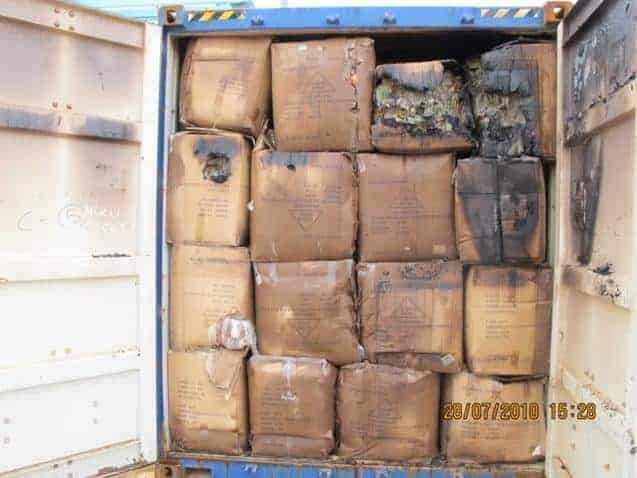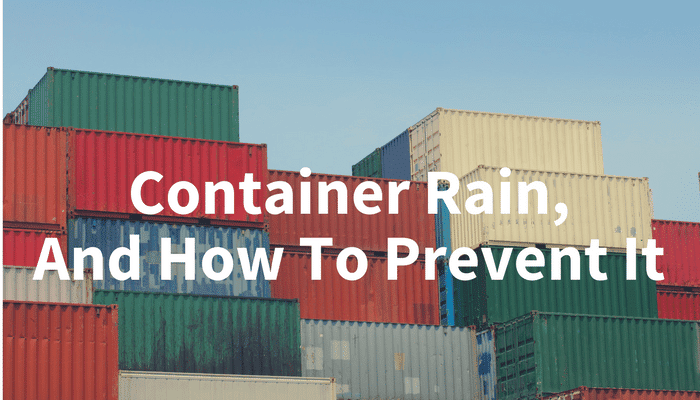Help! It’s raining inside this shipping container.
This article at a glance:
- What is Container Rain? It is harmful condensation that occurs when shipping containers move through different climates/temperatures.
- An estimated 10% of global shipments are damaged by container rain.
- Moisture can be found in the air inside of and around the product being shipped, and it can also be found in the wood and cardboard that is used to package the product.
- Mitigating container rain is something best left to packaging experts. Techniques can include using desiccant, sealing items in vapor barrier bags, dehumidifying materials before shipment, and ventilating the shipping container.
“Container Rain” is a real problem when valuable items get shipped overseas. What is it and what can you do about?
You pack and crate machinery or valuable components for overseas shipment. You do it all very carefully, being sure that nothing will be damaged and that everything is protected from shock and vibration. The crate could fall from a height of 5 feet and still everything would be intact. The items leave in a shipping container and you look forward to the acknowledgement of their reception in a perfect state. But then 5 weeks later they arrive and you get a call that says that everything has been damaged. It has been invaded by moisture: mildew and mold are everywhere and many items spent weeks sitting in a pool of water.
This is container rain. It’s a real problem in the shipping industry. According to some estimates, up to 10% of global shipments are thrown out due to unforeseen moisture problems like container rain [source]. That’s a huge hit to the bottom line.
What causes container rain?
So where does this “rain” come from? Container rain happens when the moisture inside the container encounters a temperature change that causes the moisture to turn to water. If you pack a container’s contents in Georgia in the summer (100% humidity and 100˚F air temperature) and it gets shipped to Europe through the northern Atlantic, then the temperature in the container could fluctuate 80F or more. That fluctuation means that the moisture will reach its dew point and turn into water, much like condensation forms on the outside of a cold glass of Coca-Cola in the summer.
All that moisture turns into condensation and then into humidity in a cycle that keeps it raining inside your shipment during the many weeks that it could take for it to reach its destination.

Note: this container was NOT packed by Reid Packaging!
Combating Container Rain
Container rain is all about moisture. If you can find ways of drying up the contents of your shipment, or containing the moisture in a safe way, then you’ll avoid container rain. But first, you have to understand the unlikely places where moisture can hide.
- Pallets and the wood used to make the crates can hold an incredible amount of moisture. According to this website (and this one), a single pallet could hold up to 20 liters of water, and a 40-foot container can accommodate about 40 pallets. All told that could be up to 800 liters of water that can end up raining onto your shipment and collecting at the bottom of the container. (That would be the equivalent of taking 13 showers in the container and letting the water collect at the bottom.) When you see companies storing pallets outside in a climate like we have in Georgia, this should be a red flag!
- Other hygroscopic materials, like cardboard, cotton and foam can hold moisture. Shipments that use lots of cardboard can be especially prone to moisture problems.
- The air inside of a machine or product being shipped can hold moisture as well.
Options for Preventing Container Rain
What can you do about container rain? If moisture is held in all these materials, how can you prevent it from condensing? There are a number of ways to prevent moisture from turning into rain in your container and each shipment will require a different approach depending on the circumstance. Packaging experts can help you navigate these options.
- Desiccants
Desiccants are hygroscopic (water-absorbing) materials that are used to contain moisture in the vicinity. They come in bags that can be hung in a container or included in the individual products that you are sending. When you buy shoes you’ll often see a little package of silica balls in the shoebox. This is desiccant. Often a combination of desiccant in- and outside of products is a good way to prevent moisture buildup. - Vapor Barrier Bags
Vapor barrier bags are wraps that seal off the contents of your shipment from the air around them. Vapor barrier bags are a great solution, provided that you can remove the moisture from whatever you are sealing off (often with desiccant). If there is moisture stuck on the inside of a barrier bag, then that can cause more problems than it would solve, as this moisture will not be able to escape. - Dehumidification of materials
Sometimes, you can remove the moisture from the materials you are packaging. For instance, you can use wood that has been dried, or cardboard that has been constructed with low moisture content. Additionally, working in moisture-controlled facilities will help to prevent excessive moisture in the products. (This is another reason why companies should avoid acquiring pallets that have been stored outside.) - Container Ventilation
Ventilated containers allow air to move in and out of the container which actually helps to prevent moisture build up. Many people see ventilated containers and think that it means that moisture can get in, but really it helps moisture get out.
Moisture: The Silent Enemy
When we think of protecting our shipments against damage, we most often think of impact or dropping. We imagine crushed containers, or splintered wood. In reality, it is moisture that we must protect against first and foremost. Moisture is more persistent, and more insidious. Protecting against it means understanding how it functions and where it hides.
Give us a call if you’re worried about how to protect your shipment from container rain. We’ve been ensuring safe and dry shipments for decades and we’re happy to offer our expertise. Contact us today to get more information.

